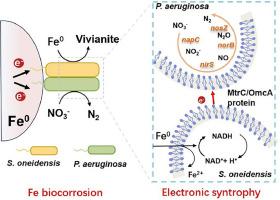当前位置:
X-MOL 学术
›
Water Res.
›
论文详情
Our official English website, www.x-mol.net, welcomes your
feedback! (Note: you will need to create a separate account there.)
Electric syntrophy-driven modulation of Fe0-dependent microbial denitrification
Water Research ( IF 11.4 ) Pub Date : 2024-10-30 , DOI: 10.1016/j.watres.2024.122722 Tianyu Gao, Ying Li, Ke Dai, Fangang Meng
Water Research ( IF 11.4 ) Pub Date : 2024-10-30 , DOI: 10.1016/j.watres.2024.122722 Tianyu Gao, Ying Li, Ke Dai, Fangang Meng

|
In natural or engineered anaerobic environments, iron oxidation-driven microbial denitrification plays a critical role in the water or wastewater treatment. Herein, we report a previously unidentified metallic iron (Fe0)-dependent denitrification mode driven by the electro-syntrophic interaction between electroactive microorganism and denitrifier. In a model denitrifying consortium of Shewanella oneidensis and Pseudomonas aeruginosa, we find that P. aeruginosa can accept electrons for nitrate reduction via the constructed electron transfer system of Fe0–S. oneidensis–P. aeruginosa. In the electro-syntrophic consortium, the membrane-bound CymA–OmcA–MtrC protein complexes of S. oneidensis drive the generation, transfer and consumption of electrons, thus enabling modulation of microbial metabolic activity. Specially, using Fe0 as the sole electron donor, S. oneidensis can act as a bio-engine to harvest electrons and conserve energy from Fe0 biocorrosion. Electrons released by S. oneidensis are utilized by P. aeruginosa for accomplishing microbial denitrification. Metatranscriptomics analysis demonstrated that the direct electron cross-feeding process facilitates the expression of genes encoding for denitrification enzymes, intracellular electron transfer proteins, and quorum sensing of P. aeruginosa. The Fe0-dependent electronic syntrophy in this work could provide a metabolic window for the growth of denitrifiers that is a new insight into nitrate removal or global nitrogen cycle.
中文翻译:

电syntrophy驱动调节Fe0依赖性微生物反硝化作用
在自然或工程厌氧环境中,铁氧化驱动的微生物反硝化在水或废水处理中起着关键作用。在此,我们报道了一种以前未鉴定的金属铁 (Fe0) 依赖性反硝化模式,该模式由电活性微生物和反硝化剂之间的电共养相互作用驱动。在 Shewanella oneidensis 和 Pseudomonas aeruginosa 的模型反化联盟中,我们发现铜绿假单胞菌可以通过构建的 Fe0-S. oneidensis-P. aeruginosa 的电子转移系统接受电子进行硝酸盐还原。在电共养联盟中,S. oneidensis 的膜结合 CymA-OmcA-MtrC 蛋白复合物驱动电子的产生、转移和消耗,从而能够调节微生物代谢活性。特别是,使用 Fe0 作为唯一的电子供体,S. oneidensis 可以充当生物引擎来收集电子并保存 Fe0 生物腐蚀的能量。铜绿假单胞菌利用 S. oneidensis 释放的电子来完成微生物反硝化。元转录组学分析表明,直接电子交叉喂养过程促进了编码反硝化酶、细胞内电子转移蛋白和铜绿假单胞菌群体感应的基因的表达。这项工作中的 Fe0 依赖性电子共养可能为反式剂的生长提供一个代谢窗口,这是对硝酸盐去除或整体氮循环的新见解。
更新日期:2024-10-30
中文翻译:

电syntrophy驱动调节Fe0依赖性微生物反硝化作用
在自然或工程厌氧环境中,铁氧化驱动的微生物反硝化在水或废水处理中起着关键作用。在此,我们报道了一种以前未鉴定的金属铁 (Fe0) 依赖性反硝化模式,该模式由电活性微生物和反硝化剂之间的电共养相互作用驱动。在 Shewanella oneidensis 和 Pseudomonas aeruginosa 的模型反化联盟中,我们发现铜绿假单胞菌可以通过构建的 Fe0-S. oneidensis-P. aeruginosa 的电子转移系统接受电子进行硝酸盐还原。在电共养联盟中,S. oneidensis 的膜结合 CymA-OmcA-MtrC 蛋白复合物驱动电子的产生、转移和消耗,从而能够调节微生物代谢活性。特别是,使用 Fe0 作为唯一的电子供体,S. oneidensis 可以充当生物引擎来收集电子并保存 Fe0 生物腐蚀的能量。铜绿假单胞菌利用 S. oneidensis 释放的电子来完成微生物反硝化。元转录组学分析表明,直接电子交叉喂养过程促进了编码反硝化酶、细胞内电子转移蛋白和铜绿假单胞菌群体感应的基因的表达。这项工作中的 Fe0 依赖性电子共养可能为反式剂的生长提供一个代谢窗口,这是对硝酸盐去除或整体氮循环的新见解。


















































 京公网安备 11010802027423号
京公网安备 11010802027423号